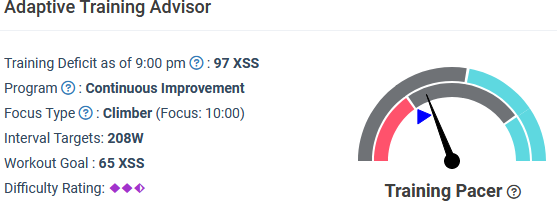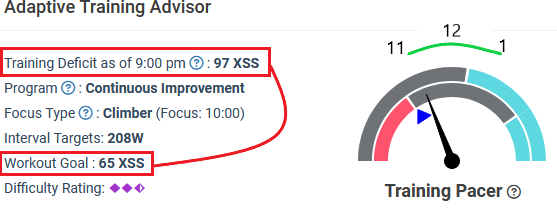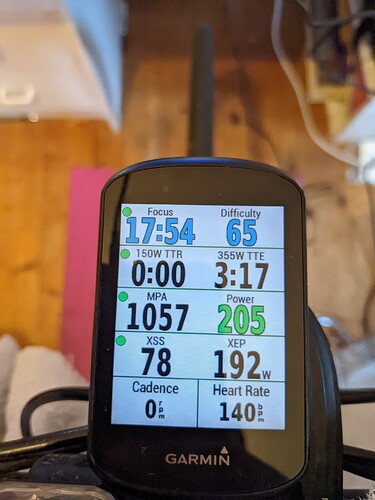Hello,
Listening to you, xert is one of the best platforms if not the best that exists to train, which I completely understand since it is the one you develop.
However, I will express some reservations. If it’s training on a connected home trainer, no problem, the power ranges are adjusted automatically by the home trainer in a precise way.
However, if you train outside. I find it impossible to pedal for example for 30 seconds at 240 w and then 3 min at x watts…
It is impossible with assioma power sensor pedals or others to be exactly at this value. The profile of the road, the wind, makes that we will be in a more or less big range around this value so the training is still distorted.
On the other hand, it is not possible, unless I am mistaken, to export the xert training on a Garmin gps which is used by many cyclists in France.
So the system is far from perfect.
No need to match targets exactly on an outdoor ride.
Those who want to attempt that will load the workout, ride to a portion of their route that supports controlled efforts, then start the workout and roughly complete it as terrain allows. The target strain ratio is your goal, not exact intervals.
Or consider the advice on the left side of the XATA page which indicates parameters for a free ride to Focus duration. You would do this instead of riding a pre-defined workout.
See this post for more info –
Xata free ride recommendation - #2 by ridgerider2
when training outside just ride to focus(sessions are designed to fit into the focus you need at that time)
Thank you for the answers. I looked at the links in the answer.
I understand better but I’m French and don’t speak English well so I use a translator but the translation is still rough so there are things I don’t understand.
Maybe a concrete example would be more meaningful.

In this example, I understand that the intervals must be done at a power of 208 w. That the difficulty on the whole output must be around 97
But how long should an interval last? If I understood correctly, the duration of the interval should be around 5 minutes. Half of the goal.
I can’t figure out what data is useful for the training. There is the objective, the difficulty and are there any others?
Out of curiosity, are there many French people who use xert?
Training deficit/surplus number refers to relative position of the pacer needle against your training load (TL) goal. That is affected by the improvement rate (IR) setting and what you have ridden in recent past on same day.
In order to provide the best answers, please post the XATA text below the pacer needle so we can see the complete picture.
I gave that as a general rule of thumb - generally, the longer the interval is, the more challenging the workout/activity will become since you will approach MPA as you continue to hold a fixed power above threshold. Do you have any hills nearby that are in the 5-8 min range? Doing some hill repeats there might be a good way to accumulate ~100 XSS at the recommended Focus!
Another way to think about this is to look at previous activities that you’ve done that had a similar Focus. Can you find any historic activities done outdoor that had a 10:00 focus?
yes they are some French speaking users. I’m Belgian, with French as mother tongue. If some help is needed, I can try to help.
Tu peux me contacter si nécessaire. Je suis un simple utilisateur depuis 2017.
à bientôt,
Pierre
Is this not the ideal use case for the connect IQ data fields? Patrick mentioned he has a Garmin GPS so hopefully can utilise them. I find them great for this use, I’d go out and warm up, then do some intervals at close to the suggested power till the focus and XSS numbers look right, then go home, it might not work out exactly as suggested but when you get a feel for it it’s surprising how close you can get.
Thank you for your answer,
It’s true that the data to be displayed on a Garmin are complete but the big problem is to interpret these data to get closer to a best possible training.
If you have to suffer on the bike, you might as well do it to progress.
Your answer allows me to see what can be displayed on the GPS.
I have a Garmin 1030.
Merci beaucoup Pierre de ta proposition.
C’est vrai que c’est plus simple de passer par le français.
Souhaites que je passe par des messages privés si c’est possible sur ce forum ou je reste sur ce fil.
N’as tu pas de problèmes avec la compréhension de l’anglais?
Patrick
I know english is not your first language so this may not help much but Scott did a video which helped me to understand using the data fields, he might add some comments when he drops by.
Thank you,
I watched this video yesterday but the automatic translation of you tube is a disaster so I didn’t understand much.
Doesn’t need to be exact but you will get better with practice… and also fair to say that’s the same no matter where a workout comes from I.e not a Xert problem, per se. You can try choosing simpler workouts, as I agree, frequent power changes can be difficult.
There is the garmin workout player though, in the ConnectIQ store. You can ride workouts outside but will have the challenge of hitting power targets still. And it stops you accessing other screens while a workout is running.
Or you should be able to download the workout (.fit file) and manually load it to your garmin (described here)
bonjour, non pas de problème en anglais. Je ne suis que rarement sur le forum. Dommage car il y a toujours des choses intéressantes à lire et apprendre. On a/développe chacun un peu sa façon de faire, et lire de temps en temps la pratique des autres peut donner de bonnes idées.
Je ne sais pas s’il existe des messages/fils d’actualités en français ou d’autres langues, je ne sais pas non plus si c’est souhaité. “Au pire” on peut le faire par mail si tu veux. L’avantage de publier ici c’est le partage.
Bonne journée,
Pierre
Hi @Patrick70 , I agree it is impossible to follow the suggested training on the spot, and I even think this is dangerous. Please allow me to describe how I adapt Xert.
In the winter I train on Sundays outside, and I train 2 days indoor. Before the week starts, I look at my target XSS for the whole week, schedule the 2 indoor-trainings and run them as is. I do not like long training indoors, so the outdoortraining is per definition a longer training with less intensitivy. After scheduling the indoortrainings, I know what is left for outdoortraining (target XSS, a target difficulty and a target focus). For example, if I need to train for 160XSS, I need to schedule an easy training for 3.5 hours (50xss per hour) or 2 hours (80XSS per hour). In the first part of the training, I try to keep pressure on it, to achieve my difficulty-score. At the end of the training, I perform some intervals to reach my focus/duration. So my advise is, perform the outdoor trainings on the macro numbers.
Hello Hagelslag,
I don’t have the same feeling as you, not being able to hold the power very precisely on the intervals is one thing. On the other hand, I don’t think it’s dangerous in itself, you have to know how to lift your head to look at the road.
I had a personal trainer (despite my low level) who made me work in zones that could have a range of 30 to 40 w so there we can get closer to the goal.
I had a well-structured program with so much time in such and such a zone and then resting for so much time and so on… No questions asked. I had made good progress but had to follow a very precise program.
In relation to the way you train. I would rather try to manage by session than by week, changing the goal according to your state of mind and your state of form.
Sometimes you want to hurt yourself and sometimes you can’t psychologically or physically.
In winter, with a connected home trainer, everything is managed automatically so no problem.
It’s especially for the warm season that I want to build outdoor programs by trying to make the xert recommendations stick with the training design and that’s where it gets complicated because you already have to understand how all the data interact with each other.
Thank you for your answer,
I didn’t know, I’ll look into it carefully.
I think this is the latest guide for the garmin workout player here
Hi Patrick, I agree on your suggestion to manage by session, much better than per week. However, I need to schedule my week, since I have a job and a family. Regarding my remark that outdoor-training could be dangerous, I meant that being on the road means that you need to take other traffic into account. Keep up the good work, courage!

In this example you will have a training deficit of 97 pts as of 9pm if you don’t ride today.
97 pts would bring the pacer needle to 12 Noon position (0 deficit/surplus).
However, 65 pts is the suggested goal based on what you have ridden in recent past on same day-of-week. If your schedule permits, you can select a workout of longer duration and accumulate more points. A needle position between 11am and 1pm is ideal to maintain the training load required to meet your improvement rate setting.
The alternative to a structured workout is the OUTDOOR free ride advice consisting of Focus Type, Interval Target, and Workout Goal.

In this case you would warm up and ride a series of irregular intervals at roughly 208 watts to attain a 10:00 Focus until you reach 65 XSS (or more if you want).
You do this by monitoring a few data fields on your Garmin (or EBC app); namely Power, Focus, and TTE/TTR.
The Difficulty field will indicate relative strain accumulated during the activity. A Difficulty Rating of 2-1/2 diamonds equates to a difficulty score of 62 to 75.
TTE/TTR field can be used to manage duration of the work interval and RIB (rest-in-between). You’re not riding an interval to exhaustion but long enough to keep the Focus number within close proximity. That’s the strain “zone” you are working on today.
For rest-in-between (RIB) you can monitor TTR (or rely on RPE) then repeat another interval when ready. Make sure your RIBs are sufficiently low intensity to recover properly.
Continue with the intervals as traffic and terrain allow until you reach your XSS goal for the day. You are now done with the workout portion of your ride. You can complete your route at an easy LTP pace.
How often you repeat intervals and for how long determines how successful you are at maintaining target Focus and how difficult the ride is. The uploaded activity will display focus, difficulty, and XSS results. I don’t remember how Garmin uploads get named but outdoor rides using EBC are titled accordingly. A successful ride to focus in this example would be titled Moderate Mixed Climber Ride. Moderate = difficulty rating, Mixed = specificity, Climber = Focus.
If you have an especially long warm-up or cooldown period, you can display stats for only that section of the chart where you performed the intervals.
Once you free ride to Focus a few times you’ll understand what’s involved and get better at it.
It takes discipline on both ends of the spectrum whether a low strain endurance ride (20:00 Focus and higher) or intervals for high/peak strain efforts (10:00 Focus and lower).
You’ll achieve your training goals for the day without any need to load a structured workout on your head unit. Instead, you can free ride a favorite loop with purpose. ![]()
Reference –
Difficulty Rating – Xert (baronbiosys.com)
Specificity Rating – Xert (baronbiosys.com)
Focus Duration – Xert (baronbiosys.com)

